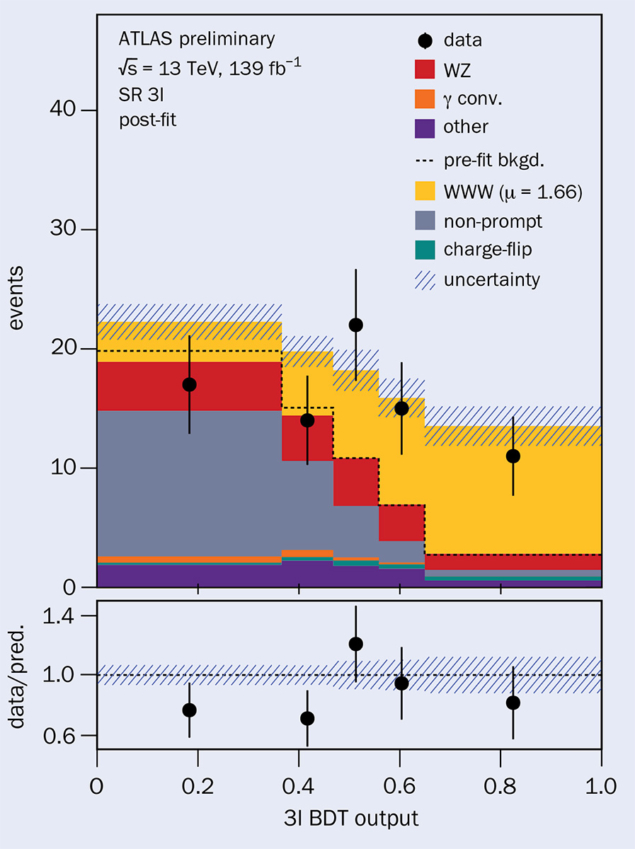A report from the ATLAS experiment

The W boson was first directly observed in 1983 using the Super Proton Synchrotron proton–antiproton collider at CERN, resulting in a Nobel Prize the following year. Almost four decades later, the ATLAS collaboration has observed the simultaneous production of three W bosons for the first time.
The possible new interactions are represented by operator terms with anomalous triple and quartic gauge couplings
The study of multi-boson processes involving boson self-interactions provides unique insight into the nature of electroweak symmetry breaking and therefore enables rigorous tests of the Standard Model (SM). Likewise, deviations from SM predictions could indicate hints of beyond-Standard Model physics through, for example, interactions that exist at energies beyond the current reach of the LHC which avoid the requirement to create the particle directly. These effects could potentially result from interactions with virtual particles in loops or new amplitudes generated by a tree-level exchange. In an effective field theory (EFT) approach, the possible new interactions are represented by operator terms with anomalous triple and quartic gauge couplings, both of which are present in WWW production.
Signal events
At leading order, the WWW signal is produced through the different mechanisms presented in the Feynman diagrams shown in figure 1. While there are many decay modes, ATLAS used four final-state channels where the signal-to-background ratio is big enough to observe the signal. The first three channels result from the decay of two of the Ws into charged lepton–neutrino pairs, with the same electric- charge sign of the charged leptons, and the decay of the third W into a pair of quarks observed as hadronic jets: the two-lepton (2l) channel, with flavour combinations ee, eμ and μμ. Additionally, WWW production is measured in the three-lepton (3l) channel, where each W decays into a charged lepton–neutrino pair, requiring no same-flavour opposite-sign charged-lepton pairs, and thus reducing the Z-boson background.

A multivariate analysis using a boosted decision tree (BDT) was used to discriminate the signal from the background, with the BDT trained using 12 discriminating input variables in the 2l channel and 11 input variables in the 3l channel. A binned maximum likelihood fit was performed on the BDT distributions with four free-floating parameters: the signal strength and three normalisation factors for the dominant WZ background. The BDT distributions were fitted in the four signal regions simultaneously with the trilepton invariant mass distribution in three WZ control regions (WZ plus 0, 1, ≥ 2 jets). The resulting BDT distribution for the 3l channel is shown in figure 2.
The large event samples (139 fb–1) provided by the full Run-2 data set, the implementation of multivariate techniques, and an improved ATLAS detector and reconstruction performance enabled the observation and the cross-section measurement of this rare process. The observed (expected) significance of the measurement is 8.2 (5.4) standard deviations compared to the hypothesis with no WWW signal. The cross section is measured to be 850 ± 100 (stat.) ± 80 (syst.) fb, as derived from the observed signal strength (the ratio of measured to predicted yields) of 1.66 ± 0.28. The observed signal significance is within 2.4σ of the SM prediction. The full Run-3 data set is anticipated to more than double the number of signal events and will enable a more precise measurement of WWW production. Higher precision cross-section measurements and detailed differential distributions will elucidate the compatibility with the SM, and an EFT approach can quantify the sensitivity to anomalous gauge couplings in a search for new physics.
Further reading
ATLAS Collab. 2021 ATLAS-CONF-2021-039.









